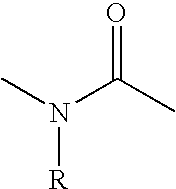Insulin Derivatives
a technology of insulin and derivatives, applied in the field of human insulin derivatives, can solve problems such as tissue inflammation at the injection si
- Summary
- Abstract
- Description
- Claims
- Application Information
AI Technical Summary
Problems solved by technology
Method used
Image
Examples
example 1
General Procedure A, Acylation Using desB30 Human Insulin
NεB29—[N—(HOOC(CH2)14CO)—N-(carboxyethyl)-CH2-para-C6H4CO] des B30 human insulin
Step 1: Synthesis of 4-[(2-tert-Butoxycarbonylethylamino)methyl]benzoic acid
[0252]
[0253] Tert-butyl 3-aminopropanoate hydrochloride (5 g, 27.7 mmol) was dissolved in methanol (150 mL). Diisopropylethylamin (4.73 mL, 27.7 mmol) was added followed by 4-carboxybenzaldehyde. The mixture is heated to reflux for 1 hour. After cooling to room temperature sodium cyanoborohydride (1.77 g, 22.1 mmol) was added under nitrogen and stirred for 1 hour at room temperature. Acetic acid (15 mL) was added and the mixture was stirred for an additional 1 hour. The mixture was poured into water (300 mL) and stirred at room temperature over night. The water solution was washed with ethyl acetate (3×250 mL). The organic phase dried (Na2SO4) and solvent removed in vacuo to yield the crude product as an oil which solidifies by standing. The crude product was used in the...
example 2
General Procedure B. Acylation Using A1,B1-diBoc desB30 Human Insulin
NεB29—[N—(HOOC(CH2)13CO)—N-(carboxyethyl)-CH2-para-C6H4CO] desB30 human insulin
Step 1: Synthesis of 4-{[(2-tert-Butoxycarbonyl-ethyl)-(14-tert-butoxycarbonyl-tetradecanoyl)-amino]-methyl}-benzoic acid 2,5-dioxo-pyrrolidin-1-yl ester
[0263]
[0264] The compound was prepared similar as described in step 2 and step 3 in general procedure A using pentadecanedioic acid mono-tert-butyl ester instead.
[0265] HPLC-MS: m / z=(709 (M+Na)); Rt=6.03 min.
Step 2: Synthesis NεB29(4-{[(2-Carboxyethyl)-(14-carboxytetradecanoyl)amino]-methyl}benzoyl) desB30 human Insulin
[0266]
[0267] A1B1 BocBoc desB30 insulin (Kurtzhals P; Havelund S; Jonassen I; Kiehr B; Larsen U D; Ribel U; Markussen J Biochemical Journal, 1995, 312, 725-731) (0.1 g, 0.017 mmol) was dissolved in DMSO (2 mL). Triethylamin (0.024 mL, 0.17 mmol) was added. 4-{[(2-tert-Butoxycarbonyl-ethyl)-(14-tert-butoxycarbonyl-tetradecanoyl)-amino]-methyl}-benzoic acid 2,5-dioxo-p...
example 3
General Procedure B
NεB29—[N—(HOOC(CH2)16CO)—N-(carboxyethyl)-CH2-para-C6H4CO] des B30 human insulin
Step 1: Synthesis of 4-{[(2-tert-Butoxycarbonyl-ethyl)-(17-tert-butoxycarbonylheptadecanoyl)amino]methyl}benzoic acid 2,5-dioxo-pyrrolidin-1-yl ester
[0269]
[0270] The compound was prepared similar as described in step 2 and step 3 in general procedure A using octadecanedioic acid mono-tert-butyl ester in stead.
[0271] HPLC-MS: m / z=(752 (M+Na)); Rt=6.62 min
Step 2: Synthesis of NεB29-(4-{[(2-Carboxyethyl)-(17-carboxyheptadecanoyl)-amino]methyl}benzoyl) desB30 human insulin
[0272]
[0273] Compound from step 1 was reacted with from A1,B1-diBoc desB30 insulin as described in general procedure B. The work up was similar using a gradient 45-70% acetonitrile / water containing 0.1% TFA. The pooled fractions containing product were lyophilized and dissolved in 2.5% NH3 1 mL and diluted to 10 mL and subjected to purification on an ÄKTA purifier employing a reversed phase HPLC, Jupiter 5269, C4 25...
PUM
| Property | Measurement | Unit |
|---|---|---|
| concentration | aaaaa | aaaaa |
| concentration | aaaaa | aaaaa |
| concentration | aaaaa | aaaaa |
Abstract
Description
Claims
Application Information
 Login to View More
Login to View More - R&D
- Intellectual Property
- Life Sciences
- Materials
- Tech Scout
- Unparalleled Data Quality
- Higher Quality Content
- 60% Fewer Hallucinations
Browse by: Latest US Patents, China's latest patents, Technical Efficacy Thesaurus, Application Domain, Technology Topic, Popular Technical Reports.
© 2025 PatSnap. All rights reserved.Legal|Privacy policy|Modern Slavery Act Transparency Statement|Sitemap|About US| Contact US: help@patsnap.com



